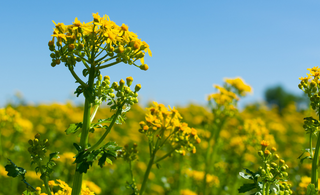
Ragwort is a common weed seen in Britain, typically found growing on grazing land, grassland and wasteland. It's a resilient plant that thrives where the ground is bare or vegetation is thin, for example on over-grazed paddocks. It can be identified by its large, flat-topped clusters of yellow flowers (seen from July through to October), its distinctive toothed leaves and its height - ragwort grows up to around 90cm/3 feet. If left to grow, ragwort spreads very easily over a wide area - their seeds are spread by the wind, with each plant capable of producing 50 - 60,000 seeds.
What is the danger of ragwort for horses?
Ragwort contains toxic compounds called pyrrolizidine alkaloids which, in sufficient quantities, can cause liver poisoning and damage in horses and livestock if eaten in any state. It's a cumulative poison that causes damage over time, eventually leading to a rapid onset of symptoms prior to death. The approximate lethal volume of ragwort for horses is around 7% of its body weight. Most horses won't choose to eat ragwort due to its bitter taste, but they will eat it if nothing else is available, accidentally, or where parts of the plant have died and become more palatable - it loses its bitter taste if it's cut, dried and found in forage like hay or haylage. However, it doesn't lose any of its toxicity and as such is still dangerous for horses to consume.
What are the symptoms of ragwort poisoning in horses?
Ragwort poisoning happens when the toxins are metabolised in the horse's liver. The toxins inhibit the division of liver cells, causing the liver to shrink in size with irreversible damage and little to no possibility of repair. With no effective treatment, euthanasia is normally the only option for poisoned horses.
Common symptoms include:
Colic/abdominal pain Diarrhoea, constipation and straining Lack of co-ordination Skin photosensitisation Yawning Apparent blindness Head pressing Collapse Coma DeathAre you responsible for dealing with ragwort?
Removing ragwort is the only way to control and prevent its spread. Because it spreads so quickly, it's a real high-risk weed on land used for grazing or forage production. Depending on your circumstances, the person responsible for control and removal of ragwort may be the landowner, yard manager, tenant or livery client - it's an important one to include in your contract, but if you're unsure form a plan with your landowner/yard manager. It's an essential job to keep on top of and not become complacent about.
How to remove ragwort
Ragwort is best dealt with at the rosette stage before flowers and seeds develop. Familiarise yourself with how to identify ragwort at this stage as it can be confused with other weeds and plants. Walk your fields regularly from March - October to identify and dig them up as soon as possible - it's easy to do this alongside poo picking.
Removing ragwort by hand is one of the best control methods. The plant should be pulled out of the ground (including the roots) and burned to prevent it from spreading - we highly recommend that you use gloves and wash your hands after handling ragwort. The easiest way to pull up ragwort is with a ragwort fork - buy yours here. Ragwort forks are designed with a unique head design and sharpened prongs for easy ground penetration., even when the ground is hard during the summer months.
Ragwort can also be sprayed with an effective weed killer. This method is more convenient if you have a larger area of ragwort to remove. We recommend using Barrier H Ragwort Killer, and removing the plants once they have died. Barrier H is a fully licensed, environmentally friendly and effective method of ragwort control. Be careful when using pesticides and always read the label carefully - most pesticides will require animals to be kept off treated areas for two weeks.

